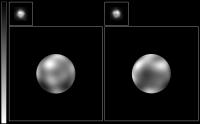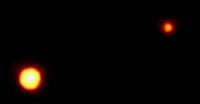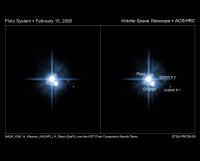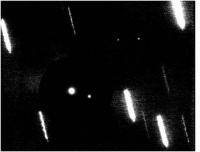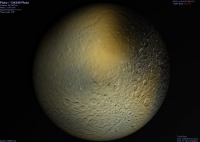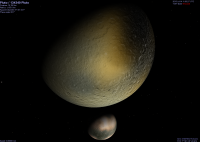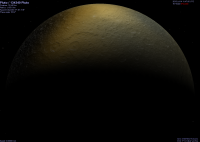Printable Version of Topic
Click here to view this topic in its original format
Unmanned Spaceflight.com _ Pluto / KBO _ New Pluto images discussed
Posted by: ngunn Feb 2 2010, 10:23 AM
Telecon announcement (via Jupiter List - thanks)
http://tech.groups.yahoo.com/group/jupiter_list/message/8170
Posted by: tedstryk Feb 2 2010, 02:51 PM
This is going to be awesome. That's all I'm saying. ![]()
Posted by: Webscientist Feb 2 2010, 05:15 PM
Signs of cryovolcanic activities? ![]()
Posted by: ElkGroveDan Feb 2 2010, 06:27 PM
Discovery of multiple bodies and/or rings?
Posted by: ugordan Feb 2 2010, 06:41 PM
I'm starting to really hate this teasing and hyping up.
I'm gonna go with rings. Or something else.
Posted by: NickF Feb 2 2010, 07:22 PM
Penguins? ![]()
Posted by: Hungry4info Feb 2 2010, 07:51 PM
We're told that the HST images will help better interpret 30 years of Pluto observations from other telescopes. This, IMHO, rules out rings and moons. I'm guessing it has something to do with the dark spots (Finally directly observed?). Been waiting for images of Pluto since HST got fixed up. Pluto and Ceres.
Posted by: ngunn Feb 2 2010, 08:01 PM
You echo my own thoughts exactly there H4I (about Ceres too). Exactly what observations over 30 years? I note that Charon was discovered in 1978. Something to do with the relationship between the two?? Rotation not exactly synchronous???
Posted by: Hungry4info Feb 2 2010, 08:02 PM
The dark spots on Pluto were found by watching mutual occultations between Pluto and Charon. As you state, Charon was found around 30 years ago. This is why direct observation of Pluto's dark spots is my guess. (Spectroscopy would be an added bonus for sure!)
If the rotation between the two wasn't exactly synchronous, that should have fudged up the light curve-derived albedo maps of Pluto and Charon.
Edit: On second thought, maybe it did. What's with those sharp longitudinal markings anyway?
Posted by: ngunn Feb 2 2010, 08:47 PM
Maybe it's those lightcurves that are now in need of 'better interpretation' meaning there was something amiss with the earlier one? Wild guesswork, but great fun. ![]()
Remember Mercury's rotation was long assumed to be synchronous, and a lot of maps had been produced on that assumption.
Posted by: NGC3314 Feb 2 2010, 09:01 PM
Odd - the HST archive search doesn't show any Pluto observations since March 2006, so these are not new WFC3 or ACS data under discussion. (Unless the target name was listed as something else...)
Maybe something to do with the changing aspect of the illuminated part of Pluto with time helping break degeneracies of where spots are, since regions in permanent sunlight didn't give a handle on what the pattern was there?
Posted by: Hungry4info Feb 2 2010, 10:04 PM
I'm not sure how this would affect anything. The albedo maps were determined from Pluto-Charon mutual occultations.
And while I remember Mercury's rotation being assumed synchronous, I'm unaware of maps based on that. o_O
Posted by: alan Feb 2 2010, 10:08 PM
I see Mike Brown is involved, my guess:
On close examination the images reveal a giant sign stating "I am too a planet"
ducks and runs ![]()
Posted by: ngunn Feb 2 2010, 10:13 PM
I think there must be new observations. Does Pluto have a Minor Planet number? I notice Mike Brown is involved and he seems to be stalked by people trying to pinch his discoveries, so (minor) subterfuge is not out of the question. I've checked his blog - no hints there.
Posted by: stevesliva Feb 2 2010, 10:17 PM
Yes. 134340 Pluto.
Posted by: stevesliva Feb 2 2010, 10:25 PM
Searched sci.astro.hubble for "Kuiper."
PERIOD COVERED: 5am January 27 - 5am January 28, 2010 (DOY 027/10:00z-028/10:00z) WFC3/UVIS/IR 11644
A Dynamical-Compositional Survey of the Kuiper Belt: A New Window Into the Formation of the Outer Solar System
The eight planets overwhelmingly dominate the solar system by mass, but their small numbers, coupled with their stochastic pasts, make it impossible to construct a unique formation history from the dynamical or compositional characteristics of them alone. In contrast, the huge numbers of small bodies scattered throughout and even beyond the planets, while insignificant by mass, provide an almost unlimited number of probes of the statistical conditions, history, and interactions in the solar system. To date, attempts to understand the formation and evolution of the Kuiper Belt have largely been dynamical
simulations where a hypothesized starting condition is evolved under the gravitational influence of the early giant planets and an attempt is made to reproduce the current observed populations. With little compositional information known for the real Kuiper Belt, the test particles in the simulation are free to have any formation location and history as long as they end at the correct point. Allowing compositional information to guide and constrain the formation,
thermal, and collisional histories of these objects would add an entire new dimension to our understanding of the evolution of the outer solar system. While ground based compositional studies have hit their flux limits already with only a few objects sampled, we propose to exploit the new capabilities of WFC3 to perform the first ever large-scale dynamical-compositional study of Kuiper Belt Objects (KBOs) and their progeny to study the chemical, dynamical, and
collisional history of the region of the giant planets. The sensitivity of the WFC3 observations will allow us to go up to two magnitudes deeper than our ground based studies, allowing us the capability of optimally selecting a target list for a large survey rather than simply taking the few objects that can be measured, as we have had to do to date. We have carefully constructed a sample of 120 objects which provides both overall breadth, for a general
understanding of these objects, plus a large enough number of objects in the individual dynamical subclass to allow detailed comparison between and within these groups. These objects will likely define the core Kuiper Belt compositional sample for years to come. While we have many specific results anticipated to come from this survey, as with any project where the field is rich, our current knowledge level is low, and a new instrument suddenly appears which can exploit vastly larger segments of the population, the potential for discovery -- both anticipated and not -- is extraordinary.
Mike Brown has been hinting at thoughts along those lines. i.e., when we found Santa and Easterbunny, they were points of light, now we're learning a lot more...
So they looked at Pluto and 119 of its closest friends.
Posted by: Hungry4info Feb 2 2010, 10:27 PM
That, almost certainly, is what this is about.
Posted by: ElkGroveDan Feb 2 2010, 10:49 PM
I get the feeling that rather than some kind of numeric study of relationships between bodies, it will relate to specific images of Pluto, its family and distinct observations made thereof.
Posted by: ngunn Feb 2 2010, 10:52 PM
Well done stevesliva! (Now, what's going on in the rest of the universe?)
EDIT: But you could be right EGD!
Posted by: volcanopele Feb 3 2010, 12:05 AM
If the dates covered in that post are the dates the data was acquired, I strongly doubt the upcoming press conference is related to it. One week is just not enough time to interpret the spectra obtained and organize them into spectral classes, IMHO. I'm with Dan on this. Based on Mike Brown's tweet, I would also expect improved knowledge of the distribution of methane ices on the surfaces of Pluto and Charon.
Posted by: stevesliva Feb 3 2010, 01:07 AM
I was wondering about that, too. Almost immediate. But there was surprisingly nothing earlier. Different keywords might help.
Posted by: NGC3314 Feb 3 2010, 02:22 AM
The archive lists 472 observations to date on program 11644, some back in September 2009, so they could possibly have enough results from that to talk about. This gets images from 0.6-1.5 microns, a couple of sets per object. Looks like they have more than half their sample observed already.
Posted by: Hungry4info Feb 3 2010, 01:22 PM
Doing a little research, I find that HST has already directly detected dark spots on Pluto.
Posted by: ElkGroveDan Feb 3 2010, 02:15 PM
Dark spots indeed. As we are a day away still, I'll go ahead and post these "best so-far" images of Pluto including the surface map generated from a full rotation over 6 days in 1994. The colored image I believe is from that same sequence. And then the 2006 image which captured the whole family.
If these were taken with the "old" Hubble I can't wait to see what the new and improved version looks like.
Posted by: tedstryk Feb 3 2010, 05:36 PM
Here is a more natural take on one of the 1996 images (not my work).
Posted by: elakdawalla Feb 3 2010, 05:48 PM
Ted and Hungry4info, what are the sources of those two images?
Posted by: Hungry4info Feb 3 2010, 05:55 PM
Ted's is HST (And was posted by ElkGroveDan as well). The one I posted is from Keck.
Posted by: machi Feb 3 2010, 06:47 PM
I don't think, that new images will be with much better resolution, than old ones. Old images were taken in UV by FOC camera and these images were diffraction limited.
All new cameras in Hubble have bigger pixel sizes. But new cameras have much better sensitivity, so I expect images with much better contrast.
Posted by: Hungry4info Feb 3 2010, 06:49 PM
Are you sure? Comparing the images of Jupiter from WFPC2 and 3, it sure looked a whole lot more detailed.
Posted by: elakdawalla Feb 3 2010, 06:59 PM
Here is http://www.planetary.org/blog/article/00002099/, but it doesn't take into account things like point spread and SNR.
Posted by: machi Feb 3 2010, 07:28 PM
Yes, but Pluto images were taken by FOC camera. But I looked at pixel sizes in Emily's article and ACS HRC is quite comparable to FOC in term of resolution and spectral range. Now I don't know precisely resolution of original FOC images of Pluto, but when I say ~0.25 arcsec, it's very close to it (FOC pixel size was 0.014 arcsec and original images was taken at wavelength 278 nm). ACS HRC has 0.028 x 0.025 arcsec pixel size and UV capability, so images with approximately same resolution and better contrast are possible.
Posted by: tedstryk Feb 3 2010, 07:29 PM
I just saved this link a while back, but it is clearly a blurred version of the right hand inset in this image.
http://hubblesite.org/newscenter/archive/releases/solar%20system/pluto/1996/09/image/a/format/small_web/
Posted by: tedstryk Feb 3 2010, 07:31 PM
The ACS HRC had a far, far superior signal to noise ration compared to the FOC. Also, the observations it made use dithering to improve resolution, a technique also used with Triton.
Posted by: Stu Feb 4 2010, 05:41 PM
Here's a link to the site covering the teleconference...
http://www.nasa.gov/news/media/newsaudio/index.html
Posted by: ElkGroveDan Feb 4 2010, 05:45 PM
Does anyone know if there is a companion page where we might observe images, charts etc?
Posted by: Stu Feb 4 2010, 05:48 PM
Haven't found one yet... maybe a link will pop up on the audio page at the start of the tc...
Posted by: elakdawalla Feb 4 2010, 05:58 PM
They usually give the link when the conference starts. Alan Boyle just tweeted http://bit.ly/bbQGVJ.
Posted by: Stu Feb 4 2010, 06:04 PM
Pix... http://hubblesite.org/newscenter/archive/releases/2010/06
Posted by: ElkGroveDan Feb 4 2010, 06:04 PM
Wow! Got the video - nice!
Posted by: elakdawalla Feb 4 2010, 06:09 PM
I think I'm going to ask what the magnitude of the albedo change was (assuming maps are stretched) -- anybody got any other question suggestions?
Posted by: ElkGroveDan Feb 4 2010, 06:26 PM
Ask if they were able to also make observations of Charon and/or its color? Could similar processes be taking place there as well?
EDIT: every time I think of a question he answers it
Posted by: MahFL Feb 4 2010, 06:31 PM
Wow he noticed the colour change in 2002 and is only telling it now ?
Posted by: MahFL Feb 4 2010, 06:40 PM
She just asked the question.
Posted by: Stu Feb 4 2010, 06:42 PM
He already explained he doubted what he saw and had to be v v sure it was real. Would you rather people just announced things like this before they were sure and ended up looking stoopid? Sheesh. A HUGE discovery, Pluto unveiled, at last, we've all got front row seats, and you're not happy? ![]()
Posted by: MahFL Feb 4 2010, 06:43 PM
Lots of unknowns..........
Posted by: stevesliva Feb 4 2010, 06:44 PM
http://hubblesite.org/newscenter/archive/releases/2010/06/full/
It's from ACS data. WFPC3 observations planned.
Is Pluto a lot closer than the other big Kuiper objects? It would be neat to see those, too.
Posted by: elakdawalla Feb 4 2010, 06:51 PM
Yes, Pluto is the closest of the big ones and the second biggest known, which is why it was discovered so long before all the others.
Posted by: volcanopele Feb 4 2010, 10:15 PM
I added the new map to my copy of Celestia, and here are some sample views from New Horizons encounter:
Posted by: Astro0 Feb 4 2010, 10:37 PM
The surfaces changes between 1994 and 2002-03 are quite dramatic.
We obviously have a quite dynamic little world out there.
Animation of the two Hubble views.
Posted by: ngunn Feb 4 2010, 10:42 PM
It would be nice to add into that animation the earlier eclipse-based albedo map.
Posted by: Ian R Feb 4 2010, 10:46 PM
Here's a fascinating "behind the scenes" article on how these neat new images of Pluto were produced:
http://www.boulder.swri.edu/~buie/pluto/mapstory.html
Posted by: tedstryk Feb 5 2010, 04:28 AM
Marc Buie has posted the full paper, including the Charon map and the comparison with the mutual events maps from the 1980s.
http://www.boulder.swri.edu/~buie/biblio/pub073.pdf
Posted by: Stu Feb 5 2010, 12:57 PM
http://www.dailymail.co.uk/sciencetech/article-1248682/Pluto-blushing-Nasa-scientists-capture-detailed-view-dwarf-planet.html
Pluto has a yellow-orange what..? ![]()
Posted by: Julius Feb 5 2010, 01:21 PM
Any plans for viewing Pluto between now and pluto encounter by Hubble?
Posted by: tedstryk Feb 5 2010, 01:57 PM
Yes - it says so in the press release, last sentence.
http://hubblesite.org/newscenter/archive/releases/2010/06/full/
The next attempt will be in the spring/summer - http://www.stsci.edu/cgi-bin/get-visit-status?id=11556&markupFormat=html
Here is the abstract - http://archive.stsci.edu/proposal_search.php?mission=hst&id=11556
Posted by: ngunn Feb 5 2010, 03:11 PM
Anybody know at what range and how long before closest approach New Horizons will match the resolution of these maps?
Posted by: Hungry4info Feb 5 2010, 03:17 PM
Ahh, that explains it. We're seeing tribal villages, and the movements on the surface correspond to migration patterns, perhaps due to a nomadic way of life.
Posted by: tedstryk Feb 5 2010, 03:28 PM
About 70 days out.
Posted by: ngunn Feb 5 2010, 03:48 PM
Thanks. (I think I heard Mike say that future Hubble images are not expected to improve the map resolution, though they will track changes.)
Posted by: tedstryk Feb 5 2010, 05:07 PM
They will likely be somewhat poorer in spatial resolution, since Hubble has no instrument on par in terms of spatial resolution with ACS HRC (repair not successful) and the long-since-removed FOC, the purpose will be monitoring change.
Posted by: AndyG Feb 5 2010, 05:33 PM
This is more dress circle I think. However, we've all booked the real front row seats - though we don't get them for five years.
Andy
Posted by: tasp Feb 5 2010, 05:50 PM
Appreciate that very much. Is the correlation between resolution and magnitude similar? In other words, is the NH camera capable of exposure times and sensitivity to see objects as faint as Hubble from 70 days out?
Maybe there are other satellites besides Nix and Hydra, perhaps larger, but much darker . . . . .
Posted by: Greg Hullender Feb 6 2010, 04:39 AM
Pluto has a yellow-orange what..?
I suspect they meant "hue" not "hut," but the possibility that there's a Howard Johnson's restaurant up there is hard to rule out. After all, there's one on the Space Station in the movie 2001.
--Greg :-)
Posted by: tedstryk Feb 6 2010, 06:02 AM
Also, there was a set taken with WF/PC2 and NICMOS in 2007. There is hope of a lower quality albedo map from the WF/PC2 data, although I don't know if this has been successful, but this would be another step in change monitoring.
Posted by: elakdawalla Feb 6 2010, 04:09 PM
I think Buie mentioned during the briefing that it wasn't possible to make this sort of map with the WPFC2 data. I know he said he didn't expect to do so with the WFC3 data.
Posted by: tedstryk Feb 7 2010, 12:19 AM
Quoting the abstract for the WFC3 observations, "A second goal of this program will be to retrieve a new epoch of albedo map for the surface of Pluto." With its high SNR and slightly better pixel resolution, it may be able to produce a new map.
Posted by: tedstryk Feb 7 2010, 12:30 AM
It is worth noting that there was some darkening observed between 1994 and 1996, so it appears that this is a continuation of the process.
These are the maps from 1994 compared to those made in 1996 for "Live from the HST" (a K-12 program).
BTW, Other than the fact that I participated online in "Live from the HST" chat/discussion sessions(I was in high school at the time), I have nothing to do with these images.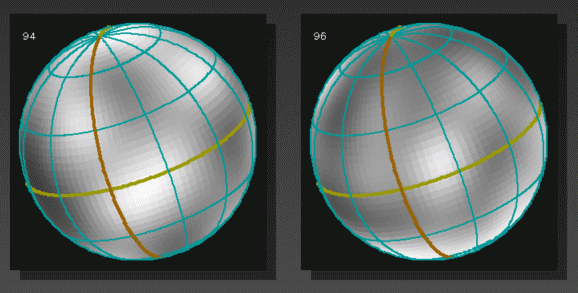
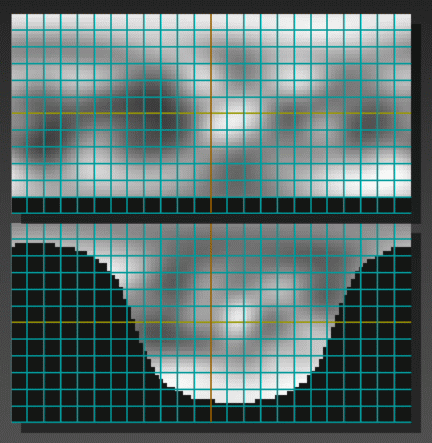
Posted by: nprev Feb 7 2010, 05:27 AM
Guess the big question here is whether we're seeing effects from outgassing, or condensation of the atmosphere, or both.
If it's atmospheric 'freezing' (probably the most likely explanation), why are the presumed deposits so globally asymmetrical? Lots of interesting questions to be answered, actually; NH may have happened at precisely the correct time to do so. ![]()
Posted by: hendric Feb 7 2010, 05:44 AM
I think the slightest albedo difference would tend to accelerate and cause differentials like Iapetus. As the planet gets farther away, the brighter locations cool down first and get more frost first.
Posted by: nprev Feb 7 2010, 05:53 AM
Ah! Yes, true; interesting how such a recent discovery dovetails with this.
Iapetus' albedo difference is quite symmetrical, though, unlike Pluto's. Still could very well be a similar mechanism at work. Pluto has a rotation period of something like 6+ days, plus the pronounced elliptical orbit; wonder how much 'mixing' happens just from that, local terrain differences aside.
Posted by: ngunn Feb 7 2010, 08:04 AM
Exactly what I was thinking. Picture different regions with different underlying albedos/textures covered in thin (partly transparent?) 'frost'. When clearing starts in a particular region the whole patch goes relatively quickly, redistributing that material to cooler regions and thus delaying the onset of clearing there - until continued seasonal warming makes the next patch go critical. Throw in the really wide seasonal temperature range expected and a multiplicity of differently coloured volatile materials and the field of possibilities seems plenty wide enough to contain these observations. It does beg the question of how complete an understanding of Pluto the severely time-limited NH observations will allow.
Posted by: Webscientist Feb 7 2010, 08:48 AM
Why are the presumed deposits so globally asymmetrical?
That's the best question we could ask here, I think!
I would answer with new questions: is it fully related to the changing atmosphere (condensation, sublimation phenomena...) or is it mainly related to an internal activity?
I've always thought that Pluto could'nt be classified as a normal planet due to its physical configuration. Let's recall that the relatively big moon Charon is only 19000 km from Pluto and that the center of mass is outside the sphere of Pluto.
As a result, we should set a special focus on the potential tidal forces from thre second Body.
Is Charon tidally-locked to Pluto?
Posted by: Phil Stooke Feb 7 2010, 01:19 PM
Charon and Pluto are tidally locked.
Regarding explanations for the albedo patterns, presumably any model also should apply to Triton, which provides a bit of a test.
Phil
Posted by: tedstryk Feb 7 2010, 01:24 PM
Yes, although Triton has much more subdued albedo patterns. HST mapped it with FOC in 1996 and with ACS in 2005 (results are still being worked on). It also took an extensive set of Triton data with STIS in 1999.
Posted by: Julius Feb 7 2010, 02:08 PM
I wouldnt be surprised if Pluto has geysers like Triton.
Posted by: Juramike Feb 7 2010, 03:01 PM
But how long ago did that happen?
Could there still be residual subsurface heat from past friction? Maybe we are detecting the Pluto version of Hotei Arcus?
Posted by: Hungry4info Feb 7 2010, 07:12 PM
With as close as Pluto and Charon are, I would presume that tidal locking happened not long after Charon's formation.
Posted by: nprev Feb 7 2010, 08:06 PM
Re residual tidal energy dissipation: That's a damn good question, and I wondered about that myself. This is very much unexplored territory, though. I don't think that we have a very good understanding yet of the thermodynamic behavior of "cryo-icy" bodies like Pluto. Bluntly speaking, this world is extremely freaking cold, and the critical points for a wide variety of materials are rather closely clustered around the expected variations in ambient temperature.
We may find that dynamism in terms of geological activity is in fact a very relative function in the context of a given world's environment. It may take far less energy to induce global changes on a body of any random composition with numerous caveats re tidal situation & solar heating levels then we've assumed. If true, this is unexpected & quite interesting.
Posted by: AndyG Feb 7 2010, 09:54 PM
All things being equal, oughtn't dark areas cool faster than bright ones?
Andy
Posted by: ugordan Feb 7 2010, 09:59 PM
Darker areas absorb more sunlight.
Posted by: Fran Ontanaya Feb 8 2010, 01:20 AM
I guess the mass displaced by the seasonal changes will be negligible compared with the mass of Pluto. If it wasn't, though, it could be a source of stress despite the tidal lock.
Posted by: Mixer Feb 8 2010, 02:46 AM
Has anybody got a link to listen to the audio of the telecon after the fact? I've been through the links but can't seem to find an archive?
Posted by: hendric Feb 8 2010, 03:34 AM
Where is the sub-Charon point on the map? My guess is that prehistoric volatiles ejected from Charon hit Pluto and caused that point to be whiter than the rest, with the heavier complex compounds with color getting left behind. My bet is that Charon is small enough that its surface ices can escape to Pluto.
Hmmm...I hadn't thought of the way they pirouette around each other. Maybe the real gathering point for the ices on Pluto would be the part of the planet leading the orbit. (where is that location on the map?)
Posted by: volcanopele Feb 8 2010, 04:03 AM
Anti-Charon hemisphere...
Posted by: imipak Feb 8 2010, 09:48 PM
Am I right to think Pluto's orbit crosses the borders of multiple sun-centred concentric zones, analagous to the habitability zone for liquid water, where many phase-space curves cluster in a fairly narrow temperature range? (Phase-spaces for what, though? Presumably the surface is covered in tholins and similar fancy hydro-carbons, with some high-albedo ices?)
Hendric's post #70 above makes me wonder whether the Iapetus albedo dichotomy and the tantalising hints about Pluto could be due to a phenomena similar to "albedo flip feedback". (NB, that's a term from terrestial climatology, a banned topic, so I'm not even going to describe it: GIYF. But it seems similar to the Iapetus story.)
Posted by: AndyG Feb 8 2010, 11:55 PM
Well, not during the three+ days of darkness. The dark areas must shed heat much faster than the light areas during that spell...
Without much/any atmosphere, dawn must result in dark/very cold areas versus light/somewhat warmer areas.
??
Andy
Posted by: nprev Feb 9 2010, 12:19 AM
All these comments certainly illuminate the potential complexity of Pluto; clearly, we need some close observations to correlate any theoretical mechanisms with reality.
5.5 more years... ![]()
Posted by: tasp Feb 9 2010, 12:53 AM
Heating of the surface will certainly be a complex topic (if 'heating' is the right word for discussing objects colder than liquid nitrogen). I have noted around here, that despite the biting winter cold, the ground remains essentially unfrozen beneath the snow drifts, and yet exposed soil is frozen solid to at least 3 feet. So to the texture and 'fluff' if you will on Pluto will factor into the penetration of the cold, or rather, the 'shallowness' of the heat (if any) dissipating from the Plutonian core. I have no idea what the 'R' values of methane snow vs. block methane ice is (or any other likely surface deposits) but the surface colors and the surface textures there will be sigificant variables. Earthly glaciers seem to compactify the snow into ice at relatively shallow depths, but the low grav on Pluto might allow even very slowly accumulating 'snows' to achieve considerable depth (and 'R' value) to occur. But then you would have something potentially quite interesting if the bottom layer flashed to vapor . . .
I am picturing almost ethereal geysers wafting from gossamer drifts, or dunes. The Tritonian analogy might be quite apt.
Posted by: remcook Feb 9 2010, 07:40 AM
"Well, not during the three+ days of darkness. The dark areas must shed heat much faster than the light areas during that spell..."
The heat is shed at different wavelengths (infrared). Only when it's 'darker' in the infrared will it shed heat faster.
Posted by: JohnVV Feb 12 2010, 08:25 AM
just something i have been working on while taking a break from the remapping of the Clementine uvis
-- the map is 2048x1024.png --
http://www.imagebam.com/image/4f4b4a67750812
based on the color map by:Marc Buie
the left is -180.0 , center is 0 and the right is 180.0
top 90 north
Posted by: imipak Feb 13 2010, 07:48 PM
Terrestrial climatology's a banned topic here; I'm mentioning this term *solely* in the context of outer planets, icy moons and suchlike.
As I understand it, the proposed mechanism for the Iapetus dichotomy and perhaps for Pluto's changing regional albedo and colour sounds like it might be analagous to a (hypothesised) phenomena known as "the albedo flip feedback". I won't describe it here, except to say that the basic idea is of temperature-related albedo changes feeding back on themselves. The question, then, is: are these outer solar-system surface albedo variations examples of A.F.F., or is A.F.F. an example of an Iapetus / Pluto / (others?) process? (And who gets to decide, anyway? Call the IAU! ![]() )
)
Does anyone know of diagrams plotting the phase spaces of the sort of gunk we might expect to see on the surface of KBOs, TNOs and Pluto, as sun-centred concentric bands? (Mebbe there are too many different species of tholins, all with slightly different temp/phase characteristics, to make that practical?) I can visualise Pluto's eccentric orbit crossing many such bands as it approaches and recedes from the sun along it's orbit, causing assorted varieties of rains, snows, hails, steams, fogs, geysers and sublimation. Perhaps you'd end up with something like a... (FSM forgive me!) ... cryo-Io, plus Titan-like surface liquid features, *plus* the sort of wacky features the CO2 condensation / sublimation cycle produces at the Martian poles. (Swiss cheese terrain, the spiders, deep canyons in the ice-caps, strong seasonal winds, etc.)
...or perhaps I should stop eating farmhouse cheddar at bedtime.
Posted by: PhilCo126 Feb 20 2010, 11:01 AM
I'm trying to get an idea of Pluto's "real" color, surely there's no "yellow" in it??? ![]()
We don't get wiser with the new NASA lithos so far:
http://www.nasa.gov/pdf/62223main_Pluto.Lithograph.pdf
http://www.nasa.gov/pdf/62223main_Pluto_Lithograph.pdf
Posted by: Juramike Feb 20 2010, 02:22 PM
That is a brilliant question. AFAIK I've not seen one, but the data just gotta be out there somewhere.
Effectively you'd be generating a "snow line", "methane line", and "ammonia line", etc.
It'd be dependent on pressure and size of the body of course, but you could lock those down as the "typical largest N2 atmospheric pressure that a Titan/Ganymede/Pluto/Triton sized body could support over a billion year period" - whatever that would be.
It' should be really useful graphic for illustrating planetary formation and evolution conditions.
EDIT:
Useful starting points:
http://www.lpi.usra.edu/books/MESSII/9028.pdf
http://weft.astro.washington.edu/courses/astro557/LODDERS.pdf (especially Table 10)
http://weft.astro.washington.edu/courses/astro557/LODDERS.pdf
Posted by: djellison Feb 20 2010, 04:02 PM
WHy not?
Posted by: JohnVV Feb 20 2010, 06:21 PM
"surely there's no "yellow" in it???"
"WHy not? "
see:
http://hubblesite.org/pubinfo/pdf/2010/06/pdf1.pdf
http://hubblesite.org/pubinfo/pdf/2010/06/pdf2.pdf
according to the pdf's that is the color and Charon is a bit on the red
[attachment=20777:JVV_Charon.png]
these are just best guess from the 12 px Hubble images
the above sort of looks like
http://www.imagebam.com/image/9f2def50688265
know what i see canals
Posted by: Lunik9 Sep 20 2010, 03:59 PM
Most NASA artist's impressions show a red-colored Pluto as red points to an advanced age. Moreover, under the influence of UV-sunlight tholin molecules might arise with a predominantly red color. ![]()
Powered by Invision Power Board (http://www.invisionboard.com)
© Invision Power Services (http://www.invisionpower.com)


